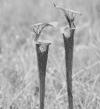- pitcher plant
-
1. any of various insectivorous New World bog plants of the genera Sarracenia, Darlingtonia, and Heliamphora, having tubular or trumpet-shaped leaves containing a liquid in which insects are trapped.2. the common pitcher plant, S. purpurea, having red or green leaves and a large, nodding, globular dull-red flower.3. any of various insectivorous Old World plants of the genus Nepenthes, having leathery leaves each ending in a tendril that bears a lidded, pitcherlike receptacle.[1810-20]
* * *
Several families include pitcher plants: Nepenthaceae (Old World pitcher plants), Cephalotaceae, Asclepiadaceae (milkweed family), and especially Sarraceniaceae (New World pitcher plants, particularly those in the eastern North American genus Sarracenia). Pitcher plants inhabit bogs, swamps, wet or sandy meadows, or savannas where the soils are water-saturated, acidic, and deficient in nitrates or phosphates. Their unusual tubular leaves have a series of nectar-secreting glands that extend from the lip down into the interior and attract insects. Once in the plant, the prey tumbles down into a liquid pool and drowns, after which an enzyme secreted within the leaf digests it, releasing nitrates and other nutrients, which supplement the meager nutrient supply of bogs. Most pitcher plants produce pitcher-shaped, insect-catching leaves in the spring and tubeless leaves in the fall. Their flowers are showy and have an agreeable scent. Yellow pitcher plant (Sarracenia flava).Jeff Lepore/Photo Reseachers
Yellow pitcher plant (Sarracenia flava).Jeff Lepore/Photo Reseachers* * *
▪ plantany carnivorous plant with pitcher-shaped leaves. Old World pitcher plants are members of the family Nepenthaceae (order Caryophyllales). New World pitcher plants belong to the family Sarraceniaceae (order Ericales). The fly-catcher plant (Cephalotus follicularis) of southwestern Australia is the only species of the family Cephalotaceae (order Oxalidales). Another pitcher plant is Dischidia rafflesiana, of the family Apocyraceae (order Gentianales). Pitcher plants are found in a wide range of habitats, from pine barrens to sandy coastal swamps—in all cases, the soil tends to be acidic and poor in nutrients.The name pitcher plant most commonly refers to members of the family Sarraceniaceae, especially the eight or nine species composing the genus Sarracenia, native to eastern North America. The other two genera in the family are the cobra plant (Darlingtonia), native to northwestern North America, and Heliamphora, native to South America.Pitcher plants of the genus Sarracenia have unusual tubular leaves that are shaped like urns, trumpets, or small pitchers, with a flap that partly covers the top of the pitcher. Insects are attracted to the mouth of the pitcher by a trail of nectar-secreting glands that extend downward along the lip to the interior of the pitcher. The lip is covered with stiff, downward-pointing hairs that are not easy for an insect to climb upward on once it has partly descended to gather nectar. Just below the lip, in the steepest part of the pitcher's throat, is a very smooth area without hairs. Like a greased slide, this zone sends the insect tumbling down into the liquid pool at the bottom of the pitcher, where it quickly becomes submersed and drowns. The insect is then digested by an enzyme secreted within the leaf.The purple, or common, pitcher plant (S. purpurea) has heavily veined, green to reddish, flaring, juglike leaves that bear downward-pointing bristles. Its flowers are purple-red. The parrot's head pitcher plant (S. psittacina) has small, fat, red-veined leaves that are topped by beaklike lids. It bears dark red flowers. The sweet pitcher plant (S. rubra) produces dull red, violet-scented flowers. The crimson pitcher plant (S. leucophylla; S. drummondii of some authorities) has white, trumpet-shaped pitchers with ruffled, upright hoods and scarlet flowers. The yellow pitcher plant (S. flava), also known as trumpets, has bright yellow flowers and a long, green, trumpet-shaped leaf the lid of which is held upright.Different species of pitcher plants cross-fertilize easily, so that the number of species varies according to the authority consulted.Cultivated species of pitcher plants from the Old World genus Nepenthes include N. dominii, N. gracilis, N. hookeriana, N. mastersiana, N. phyllamphora, and N. veitchii.* * *
Universalium. 2010.
